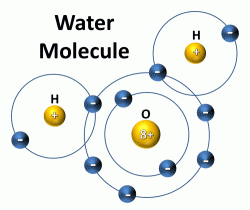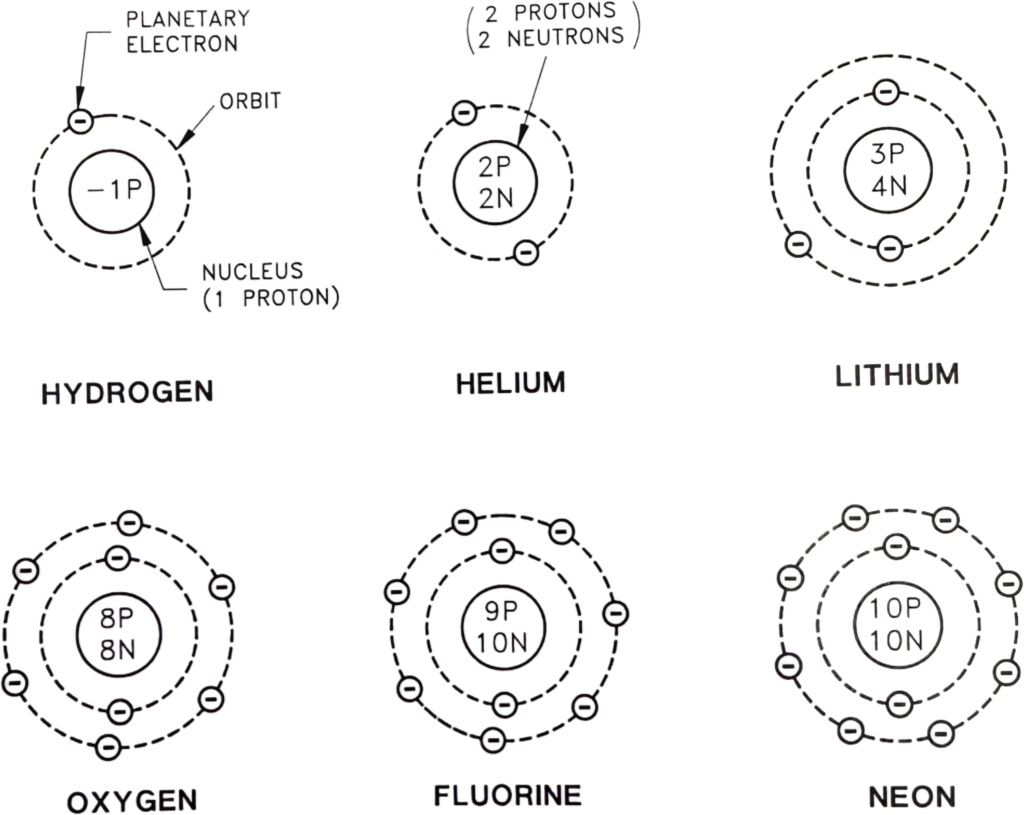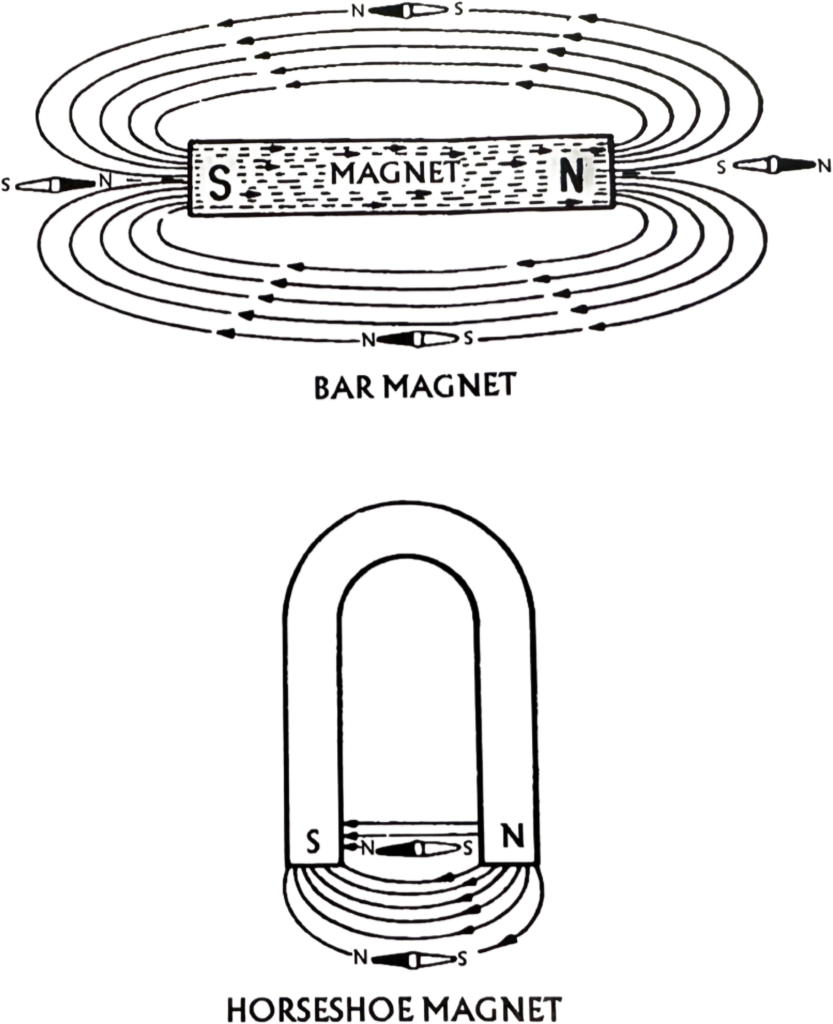Basic Electrical Principles
Electricity is the movement of electrons and is based on the Electron theory. Electron theory explains both electricity and matter. Electron theory is complex; however, the basic ideas are not difficult to understand. According to the electron theory, electrons and protons are electricity. Electrons and protons each carry a charge of electricity. The following terms provide understanding to electron theory:
- Matter is anything that occupies space and has mass
- An element is a substance which cannot be decomposed into a more simple substance. All matter is made up of combinations of these elements. For example, hydrogen and oxygen are elements which, when combined in a certain proportion, make water. The smallest division of an element is called an atom. Examples of elements are: hydrogen, carbon, oxygen, copper, zinc, tin, silver, gold, and lead.
- A molecule is the smallest particle of any substance that can exist and still retain substance properties.
- An atom is the smallest particle that an element can be divided into and remain the same element. Atoms are made up of very small particles called protons, neutrons and electrons. A good understanding of the structure of the atom is essential to understanding electricity.



Above you can see how matter is reduced to atoms and combined as molecules. In the figure you can see how a drop of water is reduced to its basic molecule. The water molecule consists of one oxygen atom and two hydrogen atoms. These atoms can each be broken down into the most basic form in which the hydrogen atom consists of one electron orbiting a nucleus containing a single positive charged proton. The oxygen atom consists of eight electrons orbiting a nucleus containing eight positive charged protons.
An atom consists of electrons, protons, and neutrons. The electron is a negative particle, the proton is a positive particle, and the neutron is a neutral particle. An atom in a normal state is neutral. This means the atom has the same number of electrons and protons and no net electrical charge.
The core of the atom is called the nucleus and contains two kinds of particles of the atom (protons and neutrons). An element is determined by the number of protons in the nucleus. For example, hydrogen has one proton and oxygen has 8 protons. Most of the mass of an atom is concentrated in the nucleus. Neutrons are neutral, having neither a positive nor a negative electrical charge. The proton has a positive charge.
The third particle of an atom is the electron. Electrons have a negative charge. Electrons revolve around the nucleus in a serious of orbits called shells. Each shell has a specific energy level associated with it. You can see below six different elements with a varying number of electrons in the outermost shell. The maximum number of electrons contained in the outer shell is based on a particular energy level. For each shell out from the nucleus, a different energy level must be reached before the next shell starts to hold electrons. An atom “tries” to fill all of its shells by accepting either electrons or giving up electrons to reach a stable state.

A substance that has atoms with loosely held free electrons is a good conductor. Good conductors with loosely held free electrons include copper, aluminum, and iron. A substance with very tightly held free electrons is a good insulator. Good insulators with tightly held free electrons include glass, porcelain, and rubber.
Substances become electrically charged by gaining or losing some electrons, as shown below. A positive charged atom has more protons than electrons. Negative charged atoms contain more electrons than protons. And a neutral atom contains an equal number of protons and electrons.

The law of attraction and repulsion applies to charged substances. This law states that like charges repeal each other and unlike charges attract each other.
Threads from the side of a table hold the balls shown below. Neutral balls do not move. The balls with like electrical charges repel each other, while the balls with unlike charges attract each other. Electricity is the flow of negative charged electrons, toward positive charged neutrons.

Magnetism and Electrcity
There are strong relationships between magnetism and electricity. It is possible to create electricity with magnetism and magnetism with electricity. Consider the nature of magnetism first.
Magnetism is a property seen in some metals like iron. “Classic” magnet types are the bar magnet and horseshoe magnets shown below. The ends of a magnet are called its poles. The poles are named north and south somewhat like the earth’s north and south poles. This is because the earth has a natural magnetic field with the north and south magnetic poles at the north and south geographic poles.
Nearly everyone is familiar with the fact that when considering two bar magnets, the north poles of the two magnets repel each other (push away from each other), as do the two south poles. On the other hand, the north pole of one magnet is attracted to the south pole of the other. This phenomenon is the reason that the south pole of a magnetized needled in a compass always points to the north pole.

Magnetism is generally described as a force field that exists around the magnet. To understand the concept of the magnetic field it is common to perform an experiment in which a piece of white paper is laid on top of a bar magnet. Iron Fillings are then poured on the paper like salt from a salt shaker. The iron fillings tend to “line up”. These lines are called lines of magnetic flux and are imagined to run from the south to the north pole of the magnet.

In fact, lines of magnetic flux do not really exists as lines on paper. The concept of lines of magnetic flux (or simply lines of flux) is useful, however, in describing the strength of a magnetic field. The more lines of flux a magnet has, the greater the strength of the magnetic field.
Electricity from magnetism
As mentioned earlier, a magnet can be used to create electricity. This is true because any time a conductor (like a copper wire) experiences a changing magnetic field, a voltage is “induced” in that conductor. Given a complete (closed electrical circuit, this induced voltage causes current to flow.
A conductor, such as a loop of wire, can be made to experience a changing magnetic field by simply moving a magnet close to the wire. Imagine an experiment in which a single loop of wire were to be connected to a very sensitive volt meter. If a bar magnet were to be waved past the loop in the downward direction, the voltmeter would jump in one direction or the other (positive or negative) depending on whether the north or south pole were held closest to the wire. If the same magnet were then waved past the wire in the upward direction the voltmeter would indicate a voltage in the opposite direction as that seen when the bar magnet were waved in the downward direction.
The magnitude of the voltage induced in the conductor depends upon the rate of change of the magnetic field. The greater the rate of change of the magnetic field, the greater the voltage. The rate of change of voltage can be varied in two different ways. First, the speed of the magnetic field with respect to the wire can be changed. If the speed is doubled, the rate of change is doubled and so the voltage is doubled. The second way the rate of change can be varied is to change the strength of the magnetic field. Thus, if two magnets were held together to double the strength of the magnetic field, while the speed remained the same, the rate of change would be doubled together with the voltage.
It will be seen later that both of these methods are used to vary the output voltage of a generator before it is synchronized. The rotor of the generator is turned into a large magnetic, the strength of which can be varied. Before a generator is synchronized, the speed of the rotor can also be varied. Generator output voltage increases as the speed of the rotor is increased and/or the magnetic field strength is increased.
Magnetism from electricity
So far, the generation of electricity with magnetism has been described. It is also possible to produce a magnetic field using electricity. In fact, any time there is current flowing through a conductor, a magnetic field is created around that conductor. If one were to place a compass needle close to a wire carrying DC current, it would be seen that there are circular lines of flux that surround the wire. The magnitude of the magnetic field depends upon the amount of current flowing, increasing as the current increases and decreasing as the current decreases.
The strength of the magnetic field around a single conductor is usually to small to be useful. A strong magnetic field can be created by forming a coil with the conductor. The magnetic fields from the adjacent turns of the coil reinforce one another and thus a much stronger magnetic field can be produced.
The strength of the magnetic field surrounding a conductor is also determined in part by the magnetic reluctance of the space through which the lines of flux must flow. Magnetic reluctance is the equivalent of resistance to the flow of current in an electrical circuit. Air and a vacuum both have a very high magnetic reluctance. The strength of the magnetic field produced by a coil can be increased considerably by placing a core of magnetic material like iron inside the coil.
Of course, when the iron core is placed in the coil, it becomes magnetized. Most people would recognize a coil wrapped around an iron core as an electromagnet. An interesting byproduct of making an electromagnet is the fact that even if the core was not magnetic before being used in an electromagnet, there will be residual magnetism in the core after the current flow through the coil stops. In fact, this is how most so called “permanent magnets” are made.

OHM’s Law, Power, And Heating in DC Circuits
Direct current (DC), circuits are circuits in which the voltage source is essentially constant, both in magnitude and polarity. A typical DC source is a storage battery. A circuit is an electrical path that allows current to flow from the positive terminal of the battery to the negative terminal.
The most fundamental relationship in DC circuits is called Ohm’s law. Ohm’s law is generally written as the following simple equation:

This equation tells us that there is a relationship between these three parameters (voltage, current and resistance) in all DC circuits. If we know two of the parameters we can use the Ohm’s law equation to calculate the third. In some cases, rearrangement of the equation using algebra is necessary. For example, for a DC circuit with a 12 volt car battery and a light bulb with a resistance of 6 ohms, the current that will flow through the light bulb is 2 amps. In order to make this calculation, the Ohm’s law equation is rewritten as
I = E/R = 12 / 6 = 2
Another relationship in DC circuits can be used to calculate the amount of power generated. This relationship is also written as an equation as follows:

Where Power is in Watts, E is voltage in volts and I is current in amps.
Finally, the two relationships described above can be used to quantify a phenomenon that is common to most people. Heat is generated any time electrical current flows through a conductor at normal temperatures. While there are exceptions (such as the heating element on an electrical stove), this generation of heat is undesirable since it means that if a device (such as a light bulb or motor) is using electrical power from a source such as a DC battery, some portion of the power used by that device is “wasted” as heat. If that heat is not dissipated as it is produced, high temperatures and damage can result.
The amount of heat genearted as current passes through a conductor can be determined by combining the equations from Ohm’s law and that for electrical power. The resulting equation is:
PH=I2×R
Where PH=Power lost to heating, I = Current in amps, R = Resistance in Ohms
As can be seen from this equation, the amount of heat produced is proportional to both the square of the current and the resistance in the circuit. Thus, if the resistance is doubled, the amount of heat produced (and lost) is also doubled. If the amount of current is doubled, however, the amount of heat is increased by a factor of four. This relationship is important because it explains, in part, why large electrical equipment is designed to operate as high as a voltage as possible. Raising voltage of a circuit reduces the amount of current required to perform the same work and thus reduces the heat loss.
These facts have resulted in electrical equipment being designed with higher and higher voltages. It is common to see, for instance, generators that generate power at 24,000 VAC. This is true despite the fact the higher voltages can be dangerous and require considerable electrical insulation.
